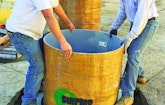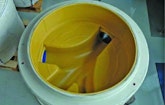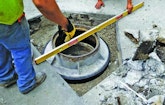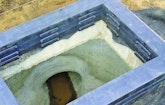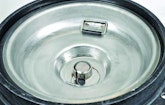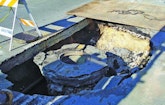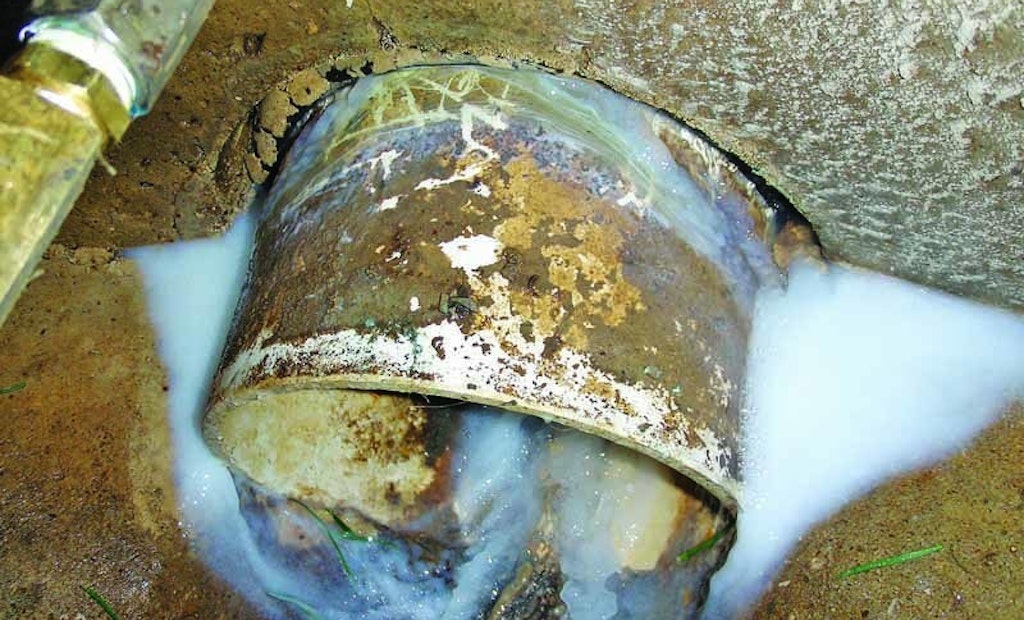Interested in Rehab/Relining?
Get Rehab/Relining articles, news and videos right in your inbox! Sign up now.
Rehab/Relining + Get AlertsLarge field sleeves provide watertight seal
Problem: The Albuquerque Bernalillo County Water Utility Authority was concerned with the close proximity of the Rio Grande River when building the Southside Wastewater Treatment plant in Albuquerque, New Mexico. They wanted to make sure two large, flexible pipe penetrations remained watertight and ensure against the possibility of this 62,000-pound junction box settling.
Solution: Premium flexible pipe-to-manhole connectors mounted in fiberglass field sleeves from A-LOK Products were chosen to guarantee a watertight seal around the 78-inch flexible, fiberglass pipe, as well as allow for the possibility of future settlement of both the pipe and junction box. A large extended base slab was also included as an anti-flotation measure. The connectors were delivered to All-American Precast, mounted in brown fiberglass field sleeves, and reinforced with wood to maintain their shape during the pour. They were mounted on the form and permanently installed in the precast base along with a liner.
Result: Once the box was stripped out of the form it was carefully moved into position by PCL Construction. They removed the wood reinforcement from inside both field sleeves and then beveled, lubed and installed the fiberglass pipe into both connectors. Two flexible watertight connections with the ability to handle differential settlement between the pipe and the structure were achieved. 800/822-2565; www.a-lok.com.
Manhole risers ease tensions on resurfaced road
Problem: A contract to resurface Routes 5 and 20 in Waterloo, New York, left out the specification to raise manholes to the new pavement height. The state needed an easy solution to fix the problem.
Solution: They decided to try the Top Hat manhole risers from Abart Industries. Eighteen manhole risers were ordered to adjust the existing low manholes. Risers ranging from 1/2 to 1 1/4 inches thick were installed using glue and mechanical fastening methods to solve the problem. The Top Hat product can be made and/or manipulated in the field to match unexpected grade changes.
Result: All manholes were brought up to grade and the New York State Department of Transportation has received many compliments on the smooth pavement and ride transition over the installed utility cover risers. 315/730-2588; www.tophatrisers.com.
Quality concerns drive use of catch basin risers
Problem: Technicians at Akron, Ohio-based Perrin Asphalt Company were concerned when they noticed that typical parking lot repaving projects tended to leave large dips around catch basins. “After a paving lift, catch basins tended to end up below grade and that was a quality issue for us,” says President Chuck Perrin. “Edges would be exposed, and degrade more quickly. So, we started looking for a better way.”
Solution: That better way turned out to be catch basin risers from American Highway Products. The steel catch basin risers are fabricated to order in precise thickness and dimension increments, and can be delivered in just a few days. They fit existing utility rims securely, providing a new seat for the original grate that leaves the grate exactly on grade, with no dips or potholes, and no exposed asphalt or concrete that will crumble quickly. Because they install in 10 minutes or less, lane closure times are also potentially reduced.
Result: “We’ve been installing at least a hundred annually for at least 15 years,” Perrin says. “And I’ve never seen one fail, not even from rust. Usually, customers don’t even know we install these risers. It’s something we do on our own so that our paving projects look better and last longer.” 888/272-2397; www.ahp1.com.
Lined manhole remains intact on collapsed sewer line
Problem: Chicago maintains a massive combined sewer system exceeding 250,000 manholes and catch basins, with tens of thousands of deteriorating century-old brick and mortar manholes. An ongoing $60 million project, initiated in 2006, involves rehabilitating thousands of manholes annually. In July and August 2010, two significant rainstorms overburdened the system, which carries sanitary waste and stormwater through the same pipes. Infiltration and erosion undermined a major sewer line, causing a section on Marquette Avenue to collapse.
Solution: The lines were lined with Permacast MS-10,000, fortified with ConmicShield from AP/M Permaform. It is an ultra-high-strength, corrosion-resistant mortar with a minimum of 3,000 psi compressive strength in the first 24 hours and very high flexural strength that prevents water migration and leaks. A final layer of epoxy was specified to protect against industrial acids and road salts. Benchmark Construction, certified Permacast system applicator, centrifugally compacted mortar against the cleaned interior manhole wall in multiple clockwise and counterclockwise passes to attain a uniform application.
Result: The rehabilitated manhole in the collapsed section remained structurally sound, significantly reducing repair costs and time. 800/662-6465; www.centripipe.com.
Lightweight grade rings provide durable solution on stormwater inlets
Problem: Illinois’ Champaign-Urbana Mass Transit District boasts over 12 million riders annually. The terminal’s concrete pavement is approximately 5 years old, and there is a constant flow of coach buses through the terminal drive, causing a problem with premature failure around stormwater inlets. The pavement surrounding three of these inlets had deteriorated and was replaced three years ago under warranty by the original contractor. The previously repaired areas had sunk and new repairs were once again needed.
Solution: Due to the premature failures of these inlets, another method of construction had to be found. The PRO-RING from Cretex Specialty Products is manufactured from expanded polypropylene, a lightweight, high-strength plastic that has an energy dissipating property, weighs 95 percent less than typical concrete grade rings, yet meets or exceeds AASHTO HS-25 loading and has excellent chemical resistance. Since they are installed using a construction adhesive/sealant, the use of the butyl rope was eliminated, resulting in a long-term repair.
Result: All three of the inlets were adjusted with the Cretex PRO-RINGs, and to date there have been no signs of pavement failure or settlement around the reconstructed inlets. 800/345-3764; www.cretexseals.com.
Manhole adjusting rings save time, increase safety
Problem: The City of Prescott, Wisconsin, had issues with concrete manhole rings failing after just a few years of service.
Solution: “I heard of the many successes that LADTECH was having in other cities across the country,” says Hank Zwart, the city’s director of Public Works. “I changed my specification to allow for LADTECH HDPE adjusting rings to be used in our city.” The riser rings can be installed in minutes. They nest together and include a 2 percent slope ring and a 1/4-inch spacer ring for a precision fit. They’re made of high-density, lightweight recycled polyethylene, meet AASHTO HS-25 axle-loading spec, and are impervious to hydrogen sulfide corrosion that destroys concrete. “They weigh only 6 pounds, compared to the 85-pound concrete rings, making them safe to handle and reducing on-the-job injuries and eliminating the need for heavy equipment,” Zwart says.
Result: Zwart says he expects the rings to be a long-term solution. 877/235-7464; www.ladtech.com.
Locking devices secure manholes at Super Bowl site
Problem: Super Bowl 50 drew worldwide media and many more fans than the 68,500 that Levi’s Stadium can hold. The event was also a tall order from logistical and security perspectives. Unsecured manholes in Santa Clara, California, posed a threat to event security and communications continuity.
Solution: More than 50 LockDown devices were installed to minimize that threat. The device sits inside manholes under the cover to prevent unauthorized access. They have been installed in military bases worldwide, at the Pentagon, in airports, telecomm areas, data centers and retail areas. The device was developed for and used to secure the 1996 Olympics in Atlanta. It is made of corrosion- and tamper-resistant, 12-gauge stainless steel, with no moving parts. It is fast and easy to install, and includes a lock guard and simple removal with the key. Modification of the manhole is typically not required.
Result: They have a success rate of 99.99 percent across more than 70,000 installs in some of the world’s most sensitive areas. This was the second Super Bowl secured with the LockDown device. 866/399-2512; www.lockdowninc.com.
Adhesives and resins provide transition between PVC liner and concrete manhole
Problem: A 2015 Baltimore, MD pipe rehabilitation project (Streets 12th-15th) required transition between previously lined with Ribloc’s Expenda PVC storm drain pipes and concrete manholes.
Solution: Neopoxy International recommended using a combination of solvent-free PVC adhesives and epoxy resins for this project. CH2M Hill workers applied a strip of PVC adhesive on the ends of Ribloc pipe and followed by coating it with highly corrosion-resistant NPR-5305 epoxy to bridge PVC material with the concrete manhole.
Result: Neopoxy’s combination of PVC adhesive and NPR-5305 epoxy resin created a reliable transition between PVC material and concrete structure. 510/782-1290; www.neopoxy.us.
Custom-made carbon FRP pipe reduces manhole repair time
Problem: The cooling system in Puerto Rico’s Aguirre Electrical Power Plant consists of a large network of pressurized pipes with 29 manholes. The top 4 feet of each manhole was corroded and required strengthening for both internal pressure and overburden pressure from nearby traffic. The plant wished to minimize the installation time and improve the quality of the FRP repair.
Solution: StifPipe from PipeMedic by QuakeWrap was selected for this project. Each section was custom made to be 4 feet long with an outside diameter of 34.5 inches. The wall consisted of a 1/4-inch-thick 3-D fabric with two layers of carbon fabric on the inside and two layers of glass fabric saturated with epoxy on the outside. This resulted in pipe that can withstand over 150 psi internal pressure. Each segment weighed only 105 pounds. In the field, segments were easily inserted in the manhole, and the small 3/4-inch annular space was filled with grout. The overall rigidity was designed to resist the external pressure independent of the host pipe.
Result: The fabrication in advance of the shutdown required for installation resulted in significantly shorter downtime and higher quality when compared to wet layup FRP. Only three hours were required to repair each manhole. 520/791-7000; www.pipemedic.com.
Watertight manhole bases save money in high-precipitation area
Problem: Pierce County, located in Washington, south of Seattle, contains 22 cities and towns linked to the Chambers Creek Regional Wastewater Treatment Plant. As with many areas in the Pacific Northwest, the region experiences heavy rainfall and high ground-water, and needed manhole bases that were watertight. In addition to the watertight connections, traditional concrete benching needed to be repaired or replaced within 10 years of installation.
Solution: Pierce County Public Works and Utilities specified and installed its first lined manhole base from PREDL Systems North America in 1989. County officials were impressed by the watertight pipe connecting bells included on all manhole base liners. The liner is a molded, wastewater-resistant PP or FRP thermoplastic concrete protective liner system of reinforced polymer with a thickness range from 0.12 to 0.20 inch, mechanically bonded with the concrete base structure during the precast concrete process. They eliminate several sources of potential errors in manhole base production ensuring the correct layout right from the start.
Result: The liners continue to provide a solution for corrosion, abrasion, exfiltration, inflow and infiltration for the entire manhole base. In a neighboring sewer district that has not specified manhole base liners, the inflow and infiltration rate increases seven times during a storm event. In Pierce County, the rate increase is just 1.5 times during the same event – a direct savings in treatment cost and plant capacity. 604/415-9944; www.predlsystems.com.
Polyurethane resin stops infiltration before lining installation
Problem: Ace Pipe Cleaning, a Carylon company in Kansas City, Missouri, has five crews doing manhole rehabilitation, including lift stations. Their bread and butter is applying epoxy coatings and cementitious linings, but in order to do that, they have to stop any active infiltrations.
Solution: They do this with low-pressure injection of Prime Flex Hydro Gel SX from Prime Resins. This single-component hydrophilic polyurethane resin reacts with water to form an impenetrable foam or gel, depending on the concentration. It is a very low-viscosity, quick-setting resin, ensuring the ability to penetrate fine cracks as well as fill larger gaps. Crews use pneumatic and electric pumps to install it in volume, though it can also be installed with the same equipment used for acrylamide grouts, including inline packers. Ace uses it to stop active infiltrations strictly in conjunction with lining, though other contractors use it by itself for sealing below-grade infiltration such as pipe penetrations.
Result: “Because it’s fast acting, it helps expedite that part of our work,” says Ace’s Bryan Dobson. “Our revenue comes from lining, so the quicker we can fully stop leaks, the sooner we can install our linings.” 800/321-7212; www.primeresins.com.
Protective coatings repair corroded concrete manholes
Problem: The City of Portland, Oregon, experienced severe manhole concrete spalling from hydrogen sulfide corrosion and cracking from the effects of natural ground movement. The structures had deteriorated over the course of 10 years and immediate repairs were required in low winter temperatures. A solution that could be quickly installed was critical to ensure downtime and road closures were kept to a minimum.
Solution: Rhino Extreme rapid-curing polyurea from Rhino Linings was specified due to its performance in extreme weather conditions and lasting corrosion resistance. Once the surface was prepped, Primer 101 was applied as a moisture barrier along with Primer 161, a flexible elastomeric polyurethane primer. To ensure continued protection against future hydrogen sulfide, manhole walls, ceilings and benches were sprayed with Rhino Extreme at variable thicknesses ranging from 1/4 to 3/8 of an inch, depending upon expected H2S exposure levels.
Result: The project was completed in one full workday. Efficient site preparation and application of Rhino Extreme has prevented and continues to prevent deterioration and chemical corrosion. The city is pleased with the quick turnaround time and the application’s performance. 800/422-2603; www.rhinoliningsindustrial.com.

